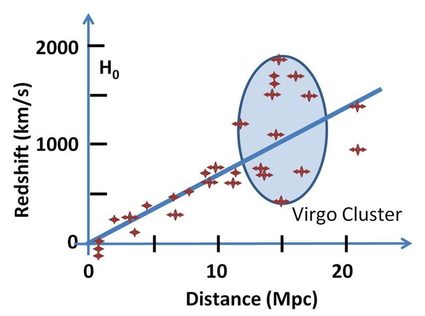Hubble's Law Calculator
Your quest to understand our expanding universe brought you to this Hubble's law calculator. With this handy tool, you can see how fast the faraway galaxies are moving away from us! You can also learn more about Hubble's law equation, the Hubble constant, and more by reading the article below.
What is Hubble's law? Hubble equation
In 1929, Edwin Hubble's study of redshifts (a consequence of Doppler effect) of distant galaxies led him to observe that all distant galaxies were moving away from us. Furthermore, the speed at which they were moving away was proportional to their distance from the Earth, meaning they were also moving away from each other. This confirmed what some other physicists had previously theorized - that the universe itself was indeed expanding!
We can state Hubble's law as:
The speed at which an object moves away from an observer is proportional to its distance from the observer.
This definition of Hubble's law can be stated mathematically as the Hubble's law equation:
Where:
- - The speed at which an object recedes, also known as recessional velocity, commonly expressed in kilometers per second (km/s);
- - Hubble's constant; and
- - The proper distance between the object and the observer, usually measured in Mega parsecs (Mpc).

The Hubble constant
There are discrepancies in the value of the Hubble constant measured using different methods. This discrepancy, dubbed the Hubble tension, hasn't been resolved even with refined techniques. We now attribute it to a gap in our fundamental understanding of the universe.
In this Hubble's law calculator, we initially set it to 70.3 km/s/Mpc, (equal to 43.68 miles/s/Mpc). Another popular choice is 67.7 km/s/Mpc, which is approximately equal to 42 miles/s/Mpc. There's a Hitchhiker's guide to the galaxy reference for you!😉
You can change this value in the advanced mode and see how the results vary with different choices of the Hubble constant.
What does Hubble's law tell us?
Hubble's law expanded our understanding of the universe in more than one way:
-
The first consequence of Hubble's law is the irrefutable fact that the universe is expanding! But wait - If the universe is expanding now, doesn't that mean that in the past, everything was closer together? Yes, Hubble's law is the first observational evidence for the Big Bang Theory, which states that everything in the universe once originated from a singularly dense point.
-
Assuming a Hubble constant of 70.3 km/s/Mpc, the Hubble equation says that a galaxy 4267 Megaparsecs away from us would be moving out at the speed of light! Meaning galaxies located farther than this recede at speeds greater than the light speed itself! But how can any object move faster than light, you ask? Well, it's not that the galaxy is moving faster than light in space-time, but that the fabric of space-time between us is expanding faster than light speed. Some galaxies lie so far away from us that any light they send would never reach us because the space between us expands faster than light.
-
Due to the universe's expansion, more and more galaxies will flee the region we call the observable universe. The night sky in the future may not be lit with as many stars. Conversely, the night sky our ancestors enjoyed had more stars in view! However, not all galaxies will vanish from our sight. Galaxies close to each other can overcome any space expansion between them thanks to gravitational force!
How to use this Hubble's law calculator
Our Hubble's law calculator is simple to use:
- Enter the distance between the celestial body and the observer, and the calculator will tell you the speed at which they're moving away from each other.
- Alternatively, provide the speed at which they're moving farther apart, and you can find the distance between them.
- In a mood to try out different Hubble constants? Click on the
advanced modebutton, and have fun!